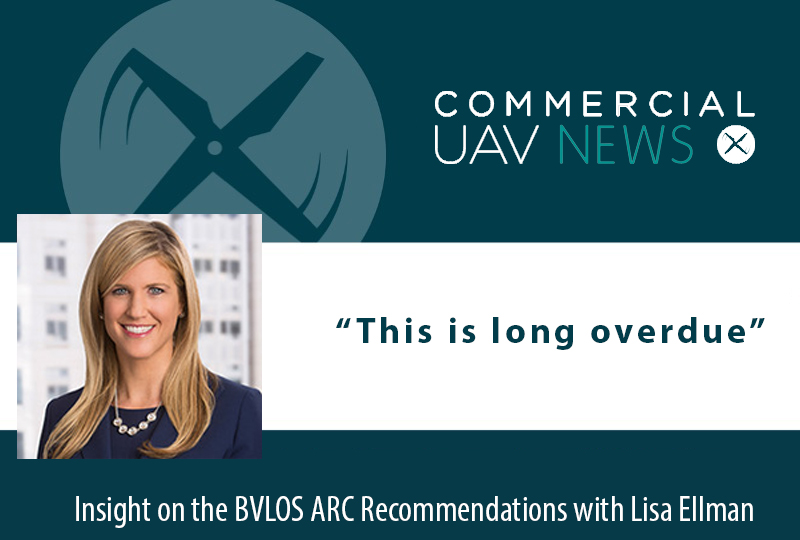Since last week’s release of the final report from the FAA’s Beyond Visual Line of Sight Aviation Rulemaking Committee (BVLOS ARC), many industry leaders, regulators, and others have offered their perspectives on the recommendations. Most have been encouraged by the report, and they are eager to see the UAV industry move forward with new guidance and clarity.
To discuss the impact of the ARC recommendations, Commercial UAV News (CUAVN) spoke with Lisa Ellman, co-founder and Executive Director of the Commercial Drone Alliance (CDA). An attorney, Ellman chairs the Uncrewed Aircraft Systems (UAS) practice at Hogan Lovells in Washington, D.C. She served as an industry lead on the committee.
CUAVN: What is your reaction to the report?
Ellman: The report is the next logical step for our industry. We’ve spent the last several years doing research and development here in United States. The industry, as well as states, localities, and test sites, have done a lot of great work. Now it’s time to be able to scale commercial drone operations here in the United States, and we have everything that we need to do it. So, this report is our industry’s attempt to work with a very diverse group of stakeholders and say, “Here's how we think we can do it and do it safely.” That’s what the FAA wanted and needed to hear, and that’s what the public needed to hear. Now it’s up to the FAA. This is long overdue.
CUAVN: Who was involved in the process?
Ellman: There was a very diverse set of stakeholders on the committee. There were representatives from 87 organizations, plus 40 or so government observers. People from all different parts of the UAS industry and ecosystem took part, but we also had representatives from the traditional aviation industry, from the privacy community, from the environmental community, and from states, tribes, and localities.
CUAVN: So, the report reflects a wide variety of viewpoints?
Ellman: The recommendations certainly represent a compromise between all the various stakeholders. But I also think they represent a critical step forward for the industry and for the American public. As this industry knows all too well, the technology has moved so quickly, but the policies have really lagged behind. If we could implement the recommendations that are laid out in the ARC report, we can help bring the industry to scale and bring sustainability, safety, and economic benefits to the American people in a way that we simply haven’t done yet.
CUAVN: The report’s major recommendations concern setting risk levels, modifying right of way rules, creating an approach to operator qualifications, establishing a BVLOS Rule with a process for qualification of UA and UAS, and adopting a regulatory scheme for third party services. How do you see these recommendations moving forward and being implemented?
Ellman: What we presented in the report was a framework, and it would be our hope that it’s a framework where all the pieces work together in order to create a safety-based, risk-based approach to enable companies to scale safely here in the US. I don’t think it was envisioned that only one piece would be implemented at a time. It’s a package, and we hope it will be rolled out as quickly as possible to cover these critical components.
CUAVN: Do you think the ARC report will help with public understanding and acceptance of commercial drones?
Ellman: The report lays out very clearly the societal benefits of drones. It discusses how this is a sustainable, clean energy transportation solution. That this is a mode of transportation that is economically viable and brings new people into aviation, including those with disabilities. The technology benefits disadvantaged and underserved communities. Also, the report shows that there are clear safety advantages to using drones for dirty, dangerous, and dull tasks. Now it’s on the CDA and others to really educate the public about those benefits.
CUAVN: You mentioned how the recommendations could help companies “scale safely” in the US. Can you explain how the recommendations could do that?
Ellman: When we considered “scale,” the committee was thinking about “What does it take for this industry to be economically viable?” Right now, you have to go through a site-by-site process in order to get approval to fly expanded operations. You need to go through a year-long exemption process just to get an approval to do an advanced research and development flight out at a local site. That’s just not scalable. So, these recommendations would broadly enable commercial drone operations to fly BVLOS by rule. But just being able to fly BVLOS by rule doesn’t mean that, all of a sudden, you’re flying everywhere all around the country, but you will at least be able to fulfill the missions of your organization, and you’ll be able to do it safely. Safety is paramount for our industry, and the ARC’s proposal will enhance safety. A major benefit of drones is the immediate safety enhancement that can be achieved in comparison to traditional legacy transportation modes. For example, many types of safety inspections require crewed helicopters that involve extra risk. Expanded drone delivery operations can also lead to fewer road mile deliveries, reducing road accidents.















Comments